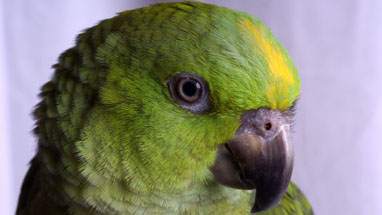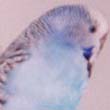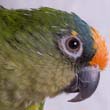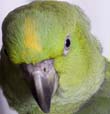In August of 2008 I was interviewed by Katie Ingmire for an article in the 2009 Birds USA magazine called:
"What It's Like To Be A . . . - Profile of Bird Careers".
Here are her questions and my answers. What made it into the magazine is posted below the questions and answers.
1.) How did you first become interested in grooming parrots?
In 1997, I took my young Peach-fronted conure, Peaches, to an avian vet to have her nails trimmed. I was in high school, and Peaches was the first bird I had ever taken in for a trim. It wasn't pretty. The vet chased her around the examination room while she screamed and crashed terrified into tables, walls, under chairs, etc… I can still remember how horrible I felt about how terrified she must have been. I didn't intervene though, and when the vet finally caught her in the towel, she dremelled her nails. Peaches was panting heavily and clenched her feet into little balls, which resulted in the vet nicking her toes in addition to her nails several times. After we left, I swore that I would never allow that to happen to her again, and I've been grooming all my birds myself ever since. I knew there had to be a less stressful way to groom birds.
2.) Where did the name "The Bird Guru" come from?
The name "The Bird Guru" came to me in 2000. I provide a number of other avian services in addition to grooming, including behavior consults, free pre-adoption/purchase consults, clicker training and behavior classes, seminars, information days in local pet stores, boarding, and avian habitat cleaning. I am constantly learning about birds in general, and parrots in particular, in every way that I can. I am an expert and mentor to my clients, so the name "The Bird Guru" works.
3.) Do you groom other animals as well? If so, what types of animals?
I groom my two dogs and rabbit myself, but other than that I don't groom any other species of animals. I am most comfortable grooming birds.
4.) What kind of education or training did you have to go through to groom parrots?
Most of my education on grooming birds came from people that I worked with directly in the field. I worked in a pet bird store in MA for almost 9 yrs, and learned how to groom from the owner of the store. I started out grooming my own birds, many budgies and my conure, and then moved on to grooming small birds at the store (primarily budgies, cockatiels, lovebirds, etc…). As my comfort and experience grew I began assisting the owner in the grooming of larger parrots. Now I will groom any type of pet bird, but I require an assistant for the larger birds (amazons, greys, cockatoos, and macaws). I've also spent considerable time observing other avian enthusiasts (breeders, vets, pet owners), talking to them about grooming, about what works for them. I've also read every parrot book, magazine, and article about grooming I could find, to further expand my knowledge. After working in a pet store for a number of years, I also worked in avian vet's office, where I saw and got to practice even more bird grooming.
5.) How did you get your foot in the door of the grooming profession?
I got my foot in the door by working in a busy pet bird specialty store in MA, and by being around people who cared enough to share their knowledge with me. When the store I was working at closed, I started "The Bird Guru". We had groomed many birds at the store, and when the business closed there was nowhere locally for many people to take their birds to be groomed, so I happily filled that void. People are happy not to have to take their birds to the vet's office multiple times per year just for grooming, and the vets that refer clients to me seem to be happy to spend their time working with the birds that need more help than just a wing and nail trim.
6.) What advice do you have for others that may want to groom parrots?
In general I don't advise people to groom their own birds, because I have heard so many horror stories. We think that just because our bird's wings are trimmed that they won't fly away, which is not the case. Clipped birds can still fly, and are only safe outside either in a harness or a carrier. Overclipped birds can hit the floor hard enough from a fall to split their keel open, requiring extensive veterinary care; clipping the wrong feathers and causing birds to have a lack of balance (clipped birds should still be able to glide downwards, they just shouldn't be able to gain much altitude) can also lead to injury; trimming blood feathers inadvertently is also a significant potential problem. A particularly tragic story I recall involved a woman attempting to clip her parakeet's wing feathers herself and instead clipping right into the bone. The bird was rushed to the closest vet and couldn't be saved. So if you want to get into bird grooming, take your time, realize that there is a lot to learn--realize that it's easy to make a mistake. Learn as much as you think you need to know to groom, and then learn even more before doing it! Spend a lot of time around parrots, perhaps getting a job working in a quality pet bird store or avian vet's office, and learn and absorb everything you can. Take your time learning about the mechanical aspects of grooming birds--which feathers to trim on which species, how many and how far up the feather. Learn about the different methods of grooming that are out there, so that you can help people make an educated choice about what is the best clip for their bird/s. Learn about the pros and cons of clipping birds, from the bird's perspective and the owner's perspective. Learn about what happens when a bird is groomed incorrectly, either over-clipped or under-clipped. Become confident grooming your own birds before you move onto other people's birds. Learn how best to groom in the least stressful way possible for the bird and owner's benefit. Learn the proper way to restrain a bird so that they can breathe easily while held in a towel. Learn to read bird body language, so that you know when a bird is too stressed. Learn some basics about avian health, so that if you stumble across a bird that appears unhealthy or underweight you can tell the owner so that they can get their bird to an avian vet as quickly as possible; in this situation I always refuse to groom the bird, as I am more concerned about the bird's health and I know that grooming can be stressful for birds, especially if the bird is not feeling well. Make sure that your grooming procedures are healthy for all involved. I travel from home to home grooming frequently, in addition to doing grooming days in pet stores. I make sure to wash my hands in between clients, and also to use a clean towel for each new household of birds I work with, to help reduce the possible transfer of any communicable avian disease. Know your limitations. Don't groom birds that you are uncomfortable grooming. Learn as much as you can, and never stop learning, there is always more to know!
7.) What bird species is the most difficult to groom? Why?
There is no one bird species that is the most difficult to groom. The birds that I think are the most difficult to groom are birds that are afraid of towels, and there are a lot of them out there. I always feel sad grooming these birds, because these are the birds that get the most stressed during the grooming process. I always recommend that people play towel games with their birds, to let their birds know that towels are safe. Bird grooming doesn't have to be stressful. A primary goal of my business is to facilitate a more positive bond of trust between parrots and their owners, and to educate people about how to make grooming less stressful for their parrots. I highly recommend Barbara Heidenreich's DVD "Training Your Parrot for the Veterinary Exam" to all my clients. It's an invaluable resource for training your bird to enjoy grooming and vet visits stress-free.
8.) What do you love about grooming parrots?
I love it that people are more comfortable handling their birds after grooming. This is what grooming is all about for me. Bird owners will be less worried their bird will accidentally get out of their house, or have a bad flight in the house and land somewhere unsafe, or just because their nails are no longer leaving marks in their skin. Grooming helps the human-avian bond because it encourages more comfortable interaction between bird and owner, and gives everyone involved a better quality of life, which is what my work is all about.
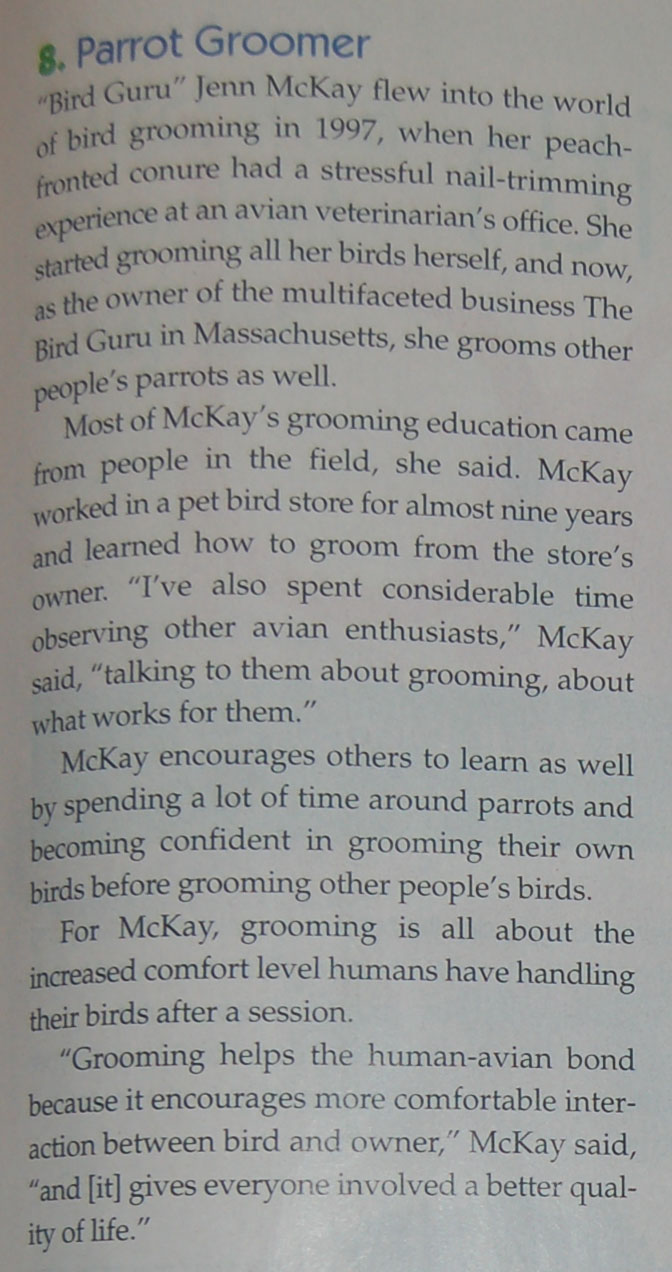
|
